Benchgrafts
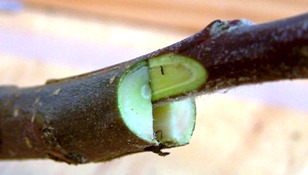 A
benchgraft is an infant tree composed of two parts; a rootstock and
a scion. The rootstock is the roots used for the tree and the
scion is a cutting of the variety the tree is to be. We do
this because apples do not reproduce true to seed, and the only way
to get an exact copy of a variety is to clone it by grafting.
They are called benchgrafts as the tree is assembled indoors during
the dormant season on a grafting bench, as opposed to outside in the
field during growing season, which is called "field budding". A
benchgraft is an infant tree composed of two parts; a rootstock and
a scion. The rootstock is the roots used for the tree and the
scion is a cutting of the variety the tree is to be. We do
this because apples do not reproduce true to seed, and the only way
to get an exact copy of a variety is to clone it by grafting.
They are called benchgrafts as the tree is assembled indoors during
the dormant season on a grafting bench, as opposed to outside in the
field during growing season, which is called "field budding".
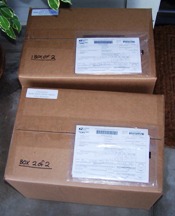 We
favor benchgrafts over 2-year-old field-dug nursery trees for
several reasons. First of all is the shipping cost; they are
much cheaper to ship as you can fit 200 of them in a 45cm box,
whereas 2-year-old nursery trees can only fit 10 or so in a 1.75
meter box. We
favor benchgrafts over 2-year-old field-dug nursery trees for
several reasons. First of all is the shipping cost; they are
much cheaper to ship as you can fit 200 of them in a 45cm box,
whereas 2-year-old nursery trees can only fit 10 or so in a 1.75
meter box.
They also grow vigorously because both the rootstock and scion
have been refrigerated, which is important in the tropics as the
2-year-old trees may have trouble with chilling requirements when
planted. It is not uncommon for them to grow 2 meters the
first season, making it hard to justify the cost of 2-year-old trees
that get their roots damaged while digging them out and branches
broken during shipping.
Finally we like them because you are able to train them yourself
during the first season, which is important as this will form the
basic structure of the tree and set the stage for early bearing.
However, because they are built from dormant rootstocks and dormant
scionwood, they are only available certain months of the year,
February through early April.
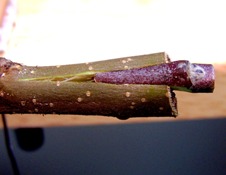 When
grafting a benchgraft, we only leave one bud from the scion variety.
We used to leave four or five, reasoning that if one bud didn't take
then the others would grow. In reality either they all take or
none of them take, so we went back to one bud. This also
leaves the scion shorter, making it less likely to be knocked out of
position during shipping and planting, and it also makes it easier
to identify what sprouts are coming from the rootstock below the
graft (which should be removed), and which is coming from the scion
itself (which needs to be trained up a stick to form the new tree). When
grafting a benchgraft, we only leave one bud from the scion variety.
We used to leave four or five, reasoning that if one bud didn't take
then the others would grow. In reality either they all take or
none of them take, so we went back to one bud. This also
leaves the scion shorter, making it less likely to be knocked out of
position during shipping and planting, and it also makes it easier
to identify what sprouts are coming from the rootstock below the
graft (which should be removed), and which is coming from the scion
itself (which needs to be trained up a stick to form the new tree).
Preventing Root Rot
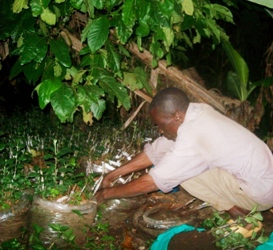 Next
to termites, the number one killer of newly-planted benchgrafts is
root rot. The benchgrafts are dormant with no leaves when
planted; with no leaves there is no transpiration going on where the
roots take up water and evaporate it out of the leaves, so the roots
will just sit in any water that's around them. If they sit too
long in the water, oxygen is cut off and rot will set in, and
the scion may sprout for a little bit and then die a couple weeks
later. People see this and assume that it's not getting enough
water, and really pour the water on, finishing off whatever life is
left. If you pull the dead tree out of the mud later, you will
see the bark is brown and rotting and the roots decomposing. Next
to termites, the number one killer of newly-planted benchgrafts is
root rot. The benchgrafts are dormant with no leaves when
planted; with no leaves there is no transpiration going on where the
roots take up water and evaporate it out of the leaves, so the roots
will just sit in any water that's around them. If they sit too
long in the water, oxygen is cut off and rot will set in, and
the scion may sprout for a little bit and then die a couple weeks
later. People see this and assume that it's not getting enough
water, and really pour the water on, finishing off whatever life is
left. If you pull the dead tree out of the mud later, you will
see the bark is brown and rotting and the roots decomposing.
To prevent this the benchgraft should be watered in once during
planting and then not again until it starts to push some leaves.
If the benchgrafts arrive during heavy rains, you may want to start
them above ground in a nursery where they can drain well, and then
transfer them to the field after they have some leaves and their
water needs increase.
Benchgraft Planting Instructions
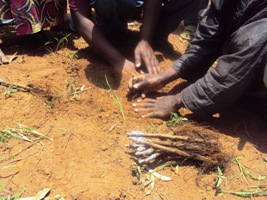 Dig
a large hole, about one meter across and at least a 30 cm deep,
breaking up the soil. Digging a large, wide hole is the best thing
you can do to give your young tree a good start, as you are
loosening the dirt so the roots can easily penetrate and thrive. If
you do now know your soil chemistry, consider having it tested so
that you can add the necessary soil amendments. If your tree is on
M111 rootstock, plant the benchgraft deep so that the M111 rootstock
does not form aerial burr knots (where roots try to form on the
trunk above ground, resulting in knobby “galls”). The graft union
should be within two fingers of the ground; on seedling rootstocks
you can have it a bit higher or lower with no danger. Dig
a large hole, about one meter across and at least a 30 cm deep,
breaking up the soil. Digging a large, wide hole is the best thing
you can do to give your young tree a good start, as you are
loosening the dirt so the roots can easily penetrate and thrive. If
you do now know your soil chemistry, consider having it tested so
that you can add the necessary soil amendments. If your tree is on
M111 rootstock, plant the benchgraft deep so that the M111 rootstock
does not form aerial burr knots (where roots try to form on the
trunk above ground, resulting in knobby “galls”). The graft union
should be within two fingers of the ground; on seedling rootstocks
you can have it a bit higher or lower with no danger.
Do not mix any
manure into the planting hold dirt;
doing
so will void your warranty. Moderate amounts of well-aged compost
is OK, but it does best sitting on top of the planting hole rather
than mixed in, especially if you have heavy clay as it will just act
as a “bucket” and prevent drainage.
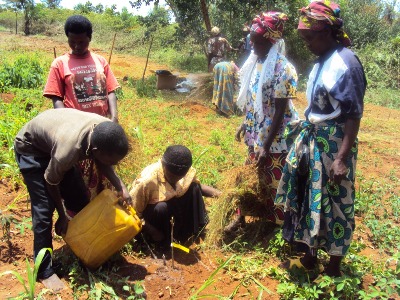 Form
a dish around the tree so it will hold water, and fill up the dish.
Allow the water to soak in, and then fill it again. This is all the
water it should have until it starts pushing leaves, or it will rot
the trunk. After the tree starts to push some leaves, mulch around
the base of the tree with grass or leaves. This mulch will
decompose over time, and the tree will send feeder roots up into it
to feed, which takes care of most of the fertilizing needs. Keep
the mulch back from the trunk a bit to avoid collar rot. Form
a dish around the tree so it will hold water, and fill up the dish.
Allow the water to soak in, and then fill it again. This is all the
water it should have until it starts pushing leaves, or it will rot
the trunk. After the tree starts to push some leaves, mulch around
the base of the tree with grass or leaves. This mulch will
decompose over time, and the tree will send feeder roots up into it
to feed, which takes care of most of the fertilizing needs. Keep
the mulch back from the trunk a bit to avoid collar rot.
Once it sprouts,
let the scion bud grow straight up. If it flowers, carefully pick
the flowers off as it is too young to fruit. Rub off any growth from
the rootstock below the graft union; if this is allowed to pass the
scion sprout, the scion will “runt out” and the rootstock growth
will dominate. Your benchgraft is wrapped with a wax tape; the
bud will sprout right through it and there is no need to cut the
tape.
You cannot just
plant an apple tree in the tropics and expect it to grow by itself
into a productive tree; you must carefully train it and the first
year is the most important. We have written a book called
Growing Apples in the Tropics that details these instructions and
has lots of photos of what you should be doing. You can see it
at the Apple Education page.
Photos: Cleft graft showing cambium layer alignment, 400 benchgraft
trees being shipped, single bud on cleft graft scion, benchgraft
nursery under the coffee and banana trees, planting benchgrafts in
Bugesera, Rwanda, watering newly planted benchgraft in Bugesera.
Home
|
Order Form |
Contact Us
©2021 Kuffel Creek |
 A
benchgraft is an infant tree composed of two parts; a rootstock and
a scion. The rootstock is the roots used for the tree and the
scion is a cutting of the variety the tree is to be. We do
this because apples do not reproduce true to seed, and the only way
to get an exact copy of a variety is to clone it by grafting.
They are called benchgrafts as the tree is assembled indoors during
the dormant season on a grafting bench, as opposed to outside in the
field during growing season, which is called "field budding".
A
benchgraft is an infant tree composed of two parts; a rootstock and
a scion. The rootstock is the roots used for the tree and the
scion is a cutting of the variety the tree is to be. We do
this because apples do not reproduce true to seed, and the only way
to get an exact copy of a variety is to clone it by grafting.
They are called benchgrafts as the tree is assembled indoors during
the dormant season on a grafting bench, as opposed to outside in the
field during growing season, which is called "field budding".
 We
favor benchgrafts over 2-year-old field-dug nursery trees for
several reasons. First of all is the shipping cost; they are
much cheaper to ship as you can fit 200 of them in a 45cm box,
whereas 2-year-old nursery trees can only fit 10 or so in a 1.75
meter box.
We
favor benchgrafts over 2-year-old field-dug nursery trees for
several reasons. First of all is the shipping cost; they are
much cheaper to ship as you can fit 200 of them in a 45cm box,
whereas 2-year-old nursery trees can only fit 10 or so in a 1.75
meter box. When
grafting a benchgraft, we only leave one bud from the scion variety.
We used to leave four or five, reasoning that if one bud didn't take
then the others would grow. In reality either they all take or
none of them take, so we went back to one bud. This also
leaves the scion shorter, making it less likely to be knocked out of
position during shipping and planting, and it also makes it easier
to identify what sprouts are coming from the rootstock below the
graft (which should be removed), and which is coming from the scion
itself (which needs to be trained up a stick to form the new tree).
When
grafting a benchgraft, we only leave one bud from the scion variety.
We used to leave four or five, reasoning that if one bud didn't take
then the others would grow. In reality either they all take or
none of them take, so we went back to one bud. This also
leaves the scion shorter, making it less likely to be knocked out of
position during shipping and planting, and it also makes it easier
to identify what sprouts are coming from the rootstock below the
graft (which should be removed), and which is coming from the scion
itself (which needs to be trained up a stick to form the new tree). Next
to termites, the number one killer of newly-planted benchgrafts is
root rot. The benchgrafts are dormant with no leaves when
planted; with no leaves there is no transpiration going on where the
roots take up water and evaporate it out of the leaves, so the roots
will just sit in any water that's around them. If they sit too
long in the water, oxygen is cut off and rot will set in, and
the scion may sprout for a little bit and then die a couple weeks
later. People see this and assume that it's not getting enough
water, and really pour the water on, finishing off whatever life is
left. If you pull the dead tree out of the mud later, you will
see the bark is brown and rotting and the roots decomposing.
Next
to termites, the number one killer of newly-planted benchgrafts is
root rot. The benchgrafts are dormant with no leaves when
planted; with no leaves there is no transpiration going on where the
roots take up water and evaporate it out of the leaves, so the roots
will just sit in any water that's around them. If they sit too
long in the water, oxygen is cut off and rot will set in, and
the scion may sprout for a little bit and then die a couple weeks
later. People see this and assume that it's not getting enough
water, and really pour the water on, finishing off whatever life is
left. If you pull the dead tree out of the mud later, you will
see the bark is brown and rotting and the roots decomposing.